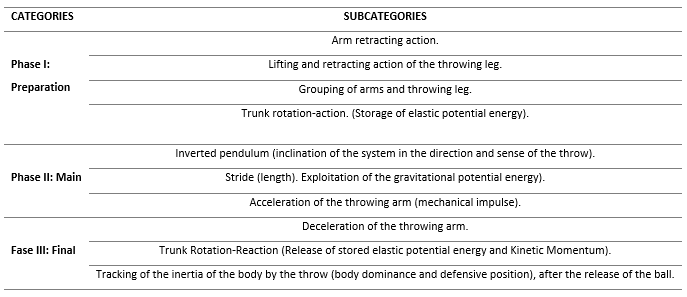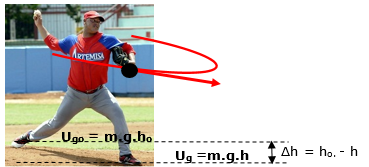Mi SciELO
Servicios Personalizados
Articulo
Indicadores
-
 Citado por SciELO
Citado por SciELO
Links relacionados
-
 Similares en
SciELO
Similares en
SciELO
Compartir
Podium. Revista de Ciencia y Tecnología en la Cultura Física
versión On-line ISSN 1996-2452
Rev Podium vol.16 no.2 Pinar del Río mayo.-ago. 2021 Epub 01-Ago-2021
Original article
Physical foundations of the pitcher's technical gesture
1Universidad de Pinar del Río "Hermanos Saíz Montes de Oca", Pinar del Río, Cuba.
The greed to throw hard in baseball, plus the mechanical-energetic ignorance of the contribution and what prevents the correct execution of the phases of the pitcher's technical gesture, turned out to be the main causes of injuries and the reason for an explanatory research, through the application of physical kinematic, dynamic and energetic methods, in the study of the manifestation of physical laws during the non-participatory observation of their performance, when throwing the ball, both in national and international pitchers and testimonies of people with experiences as pitchers. The objective of this article is to propose a physical explanation of how the biomechanics of the pitcher's body works during the technical gestures of pitching to guarantee a fast ball and minimize injuries. With this work, it is also intended to instruct the pitcher on how the biomechanics of his body works during the pitching of the ball, taking advantage of the height of the mound with arguments from the physical science. This contributes to faster, more elegant pitches and to minimize injuries. As a result, a physical explanation by phases was elaborated for the pitcher, in addition, an isolated mass-spring system to experiment biomechanical and energetic movements, which evidenced in their performance manifestations of the physical laws of Newton's classical mechanics, conservation of mechanical energy, kinetic momentum and angular momentum.
Key words: Pitcher's physics; Pitcher's technical gesture; Pitcher's injuries.
INTRODUCTION
Baseball is not one of the most difficult sports in existence, but the most difficult, according to Robert K. Adair (Sáiz Domínguez, 2016), author of the book entitled: The Physics of Baseball. When referring to the pitcher, he made the following comparison, taking up expressions made by great and renowned physicists such as Copernicus, Galileo or Kepler: "Just as the Earth revolves around the Sun, the pitcher's mound is the center of a system around which revolve, as if they were planets in their orbit, the three bases and the home plate".
In the Forum of the Faculty of Chemistry of the Unam-Mexico, under the slogan: Science beyond the classroom, the researcher Jorge Flores Valdés of Ifunam (Flores Valdés, 2016), in his lecture entitled: Physics in baseball returns to this universal and popular sport to highlight that there is a lot of physics in baseball and that most people do not know it, citing several examples of which are summarized, only two of interest for this article:
The speed with which a pitcher throws the ball can exceed 150 km/h (more than 94 mph), in a distance of a little more than 18 m., decreasing so much the reaction time of the batter, that it is almost impossible to hit the ball. He gives as an example the 106.9 mph (172.04 km/h) pitch of Cuban Aroldis Chapmanen, the American major league baseball, a record with a fast straight line that needed only 0.39 s (390 ms) to reach the catcher's glove, much less than half a second. A ball at that speed can travel that distance in one second about 2.6 times that distance.
The height of the mound is justified because the pitched ball falls a lot in its trajectory to home plate due to the earth's gravitational attraction, for example: a fast ball falls 0.50 m. and a slow ball (a curve) falls 1.5 m., therefore, the faster the ball moves, the lower its fall to earth, as well as the time it takes to reach home plate.
The researcher concludes and highlights the usefulness of this knowledge in baseball players and expresses: Teaching Physics to athletes is useless, what would be useful is to teach them more biomechanics so that they know how their body works; this phrase was the trigger to carry out this explanatory research and also to address the constant concern of the sports doctor of the Pinar del Río baseball team, given the continuous injuries of the pitchers, with the high probability of not concluding the season, mainly due to the desire to throw hard, plus the mechanical-energetic ignorance of what contributes and prevents the correct execution of the three stages or phases of the technical gesture of the Cuban pitcher (Martínez, 2012).
As popular belief says: pitching is the most important part of the baseball game, therefore, the mastery or skill in the mastery of the pitcher´s biomechanics body can make the difference between losing and winning a game (Becerra & Sánchez, 2016).
In general, young people are recruited to throw hard, which is not enough and the coach has to convince them with arguments from the science Physics, showing them why they must comply with the three phases of the regulated technical gesture and how the biomechanics of their body works during the pitching of the ball, guaranteeing the triumph with elegance and avoiding suffering injuries, without forgetting the advantage over the batter, taking advantage of the elevation of the mound.
Therefore, a descriptive study of the possible manifestation of the physical laws is required through the non-participatory observation of the pitcher's performance, when throwing the ball, both in national and international pitchers and to collect testimonies in interviews with people with experience in the art of pitching in baseball, in order to determine which fundamentals of physical science contribute to the physical explanation of why each movement should be performed in the different phases of the pitching and the use of the mound.
The biomechanical-energetic movements of translation and rotation, manifested in the pitcher's technical gesture, require a logical, uninterrupted, synchronized and dependent sequence, until the ball is released as the final product, based on the laws of Newton's classical mechanics and the conservation of mechanical energy and/or kinetic momentum and angular momentum (Sears and Zemansky & Young and Freedman, 2013).
For these reasons, the objective of this article is to propose a physical explanation of how the biomechanics of the pitcher's body works during the technical gestures of pitching to ensure a fastball and minimize injuries.
MATERIALS AND METHODS
The empirical method of non-participatory observation was applied, with the objective of identifying in a sample of 60 pitchers, both national and international, the fulfillment of each phase in the technical gesture of the Cuban pitcher (Figure 1).
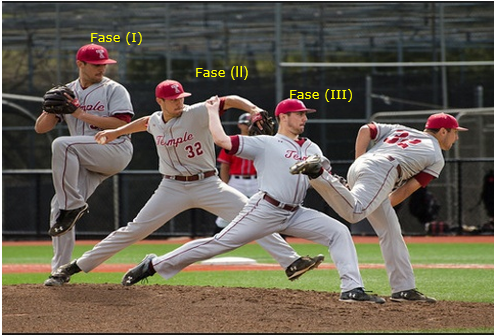 Source: (Cortinas, 2016).
Source: (Cortinas, 2016).Fig. 1. - Pitcher's throwing phases: (I) preparation phase; (II) main phase and (III) final pase
The observation was carried out based on the fulfillment or not of the categories and subcategories assumed in the observation guide (Table 1), evaluated by the authors: three graduates: one in Physics and two in Physical Culture; all professors of the University of Pinar del Río "Hermanos Saíz Montes de Oca", who maintain the criterion of unanimity of its manifestation during the correct execution of the technical gesture.
The materials used for the observation were:
Youtube videos to analyze the performance of national and international pitchers.
Games of the LVIII and LIX National Baseball Series, broadcasted by Cuban television.
Games of the LIX National Baseball Series, played at the "Capitán San Luis" Stadium in Pinar del Río.
An interview was applied to nine male persons from "Nancy Uranga Ramagoza" (six) and "Hermanos Saíz" (three) university campuses, both of the University of Pinar del Río "Hermanos Saíz Montes de Oca", who have been pitchers and/or connoisseurs of the technical gesture, as part of their professional training in Physical Culture. The questionnaire consisted of two closed questions: (1) Could you describe and execute the phases of the Cuban pitcher's technical gesture; and (2) Why do you think they should be done that way?
Likewise, the kinematic, dynamic and energetic physical methods were applied, considering the pitcher as a mass-spring system, pitcher-ball, isolated from any external action (of mechanical impulses and zero external torques) to find the physical explanation as an argument of the execution of the phases of the technical gesture in the pitcher's biomechanics, when he experiences translation and rotation movements as a consequence of the application of the action-spring principle, defined by the authors, where the action force corresponds to the grouping and torsion of the trunk of the body (phase I of the technical gesture), which behaves as a spring or deformed torsion spring, storing elastic and gravitational potential energies.
The reaction force was manifested during the elastic restitution of muscles and tendons deformed during the action, where all that stored energy is released with certain explosiveness, and as a consequence of the manifestation of the physical laws of conservation of mechanical energy, kinetic momentum and angular momentum, which facilitated the interpretation of the possible transformations of the physical magnitudes stored and released during the entire technical gesture.
RESULTS AND DISCUSSION
As a result of the observations made to the 60 pitchers, the following results were obtained, described by phases.
Phase (I) of preparation: 43. 3 % of the pitchers observed complied with this phase, they correspond to pitchers, generally fast and elegant on the mound, examples of nationals such as: Jesús Guerra, Omar Ajete, Faustino Corrales, Braudilio Vinent, Rogelio García, Lázaro de la Torre, Manolo Hurtado, Bosmenier, Changa Mederos, Duque Hernández, Norge Luis Vera, Liván Moinelo and Lázaro Blanco; as for international MLB pitchers, examples such as: Aroldis Chapman, Hideo Nomo, Johnny Cueto, Orlando Hernandez, Satchel Paige, Dontrelle Wills, Luis Taint, Alex Cobb, Alex Wood, Mak Rzepczinski, Juan Marshall, Nolan Ryan and Ubaldo Jimenez.
Phase (II) main: 51.7 % satisfied the evaluation criteria, it is highlighted that some of the national pitchers of reference in phase (I) achieved large strides and are fast pitchers, although others did not comply rigorously with phase (I). They did worry with a wide stride, to name a few: Pedro Luis Lazo, Omar Ajete, Faustino Corrales, Rogelio Garcia, Lazaro Blanco and others.
De los lanzadores internacionales de la MLB: Satchel Paige, Alex Cobb, John Gant, Carter Capps, Daisuke Matsusaka, Jordan Walden, Joe Smith, Rubén García, entre otros.
Phase (III) Final: it was considered that 55.0 % of the observed pitchers complied with this final phase, some of them forced to decelerate the arm and counteract the inertia of the body as they were able to do it; sometimes, losing the balance and leaving the mound totally lackluster and defenseless before any hit. It is the phase where only the fastest pitchers and recognized for their high performance show a clean and elegant final phase of the pitch, as, for example, among the nationals: Braudilio Vinent, Omar Ajete, René Arocha, Lázaro de la Torre, Liván Moinelo, among others and the internationals: Alex Cobb, Alex Wood, Juan Marshall, Mak Rzepcznski and other authors.
Of those interviewed, 100 % mastered the three phases of Cuban pitching and how to execute them, however, none was able to meet the evaluation criteria, regarding the identification of the type of energy that is stored and released in the kinetic sequence, with the knowledge that there is energy involved, that energy is accumulated and discharged with the pitch, as well as that these gestures should be done so to minimize elbow and throwing shoulder injuries, but they do not know how to distinguish which energy or energies, where and how they are obtained. Something similar was observed in other bibliographies specialized in baseball.
The application of the physical methods allowed identifying the physical laws that were manifested during the pitcher's performance in each of the regulated phases and as a result a proposal of the physical explanation of the pitcher's technical gesture is elaborated, which gives an answer to the questions of why the name and necessity of the fulfillment of each regulated phase, delimited by insignificant margins of time (without pauses), given the explosiveness and speed to be achieved with the technical gesture, described step by step for a right-handed pitcher, facing the batter, without runners on the bases and the type of pitch most used in the games, the fast straight and over the arm, also valid for a left-handed pitcher.
Physical explanation of the phase I: preparation phase
Why preparation phase, preparation of what and for what? are questions that the novice pitchers ask themselves when they are in the learning phase, starting the explanation with the correct pitcher's posture, from the regulation position on the pitching rubber, with his right foot of uni or monopodal support and the body oriented laterally towards the home plate, achieving the greatest stability of the isolated pitcher-ball mechanical system to perform the action of elevation, collection and grouping of his upper limbs, together with the ball in the glove and approach of the left leg of attack or pitching towards the sagittal midplane of the body and its Center of Gravity "CG" (black circle), where the line of gravity should be (black dashed vertical line) (Garcia & Rodriguez, 2015) (Figure 2) and thus apply the Action-Reset principle with the synchronization of all internal interactions that occur during translational and rotational movements.
Such grouping, regardless of Wind-up style (Figure 2) ensures proper distribution of body gravitational mass relative to weight (P=M.g) (Sears and Zemansky & Young and Freedman, 2013, p. 119) to concentrate more body mass to the axis of rotation and an increase in gravitational potential energy that is stored in the system, with instantaneous and progressive decrease in the moment of inertia (I) of the system.
(Sears and Zemansky & Young and Freedman, 2013, p. 289), which contributes to a rapid and explosive angular velocity, as a consequence of the law of conservation of angular momentum.
 Source: https://www.gettyimages.es/detail/foto/you-cant-coach-this-kind-of-skill-imagen-libre-de-derechos/1226418891?adppopup=true
Source: https://www.gettyimages.es/detail/foto/you-cant-coach-this-kind-of-skill-imagen-libre-de-derechos/1226418891?adppopup=true
Fig. 2. - Grouping of arms and throwing leg, rotation of the trunk (Action)
Reaching the maximum point of balance high enough, with the maximum torsion of the hip, a requirement in this phase, is achieved with the mastery and internal control of the biomechanics of his body, taking care not to exceed in the rotation, as the body CG would move backwards from the pitcher and affect his posture, subtracting elegance and power to the pitch, with the imperious need to force the throwing arm and shoulder to achieve the speed of the ball he thinks he would achieve, plus a greater effort in achieving control of the pitch.
For this reason, it is called the preparation phase of the pitcher's body, given the amount of mechanical energy it stores, and from here, knowing how to release it with the control of the angular velocity that it will surely achieve, due to the restoring torques caused by that torsion or semi-rotation, with a certain angle with respect to the imaginary vertical axis (slightly showing the number of the back in its uniform), the system behaving like a torsion spring, a type of spring that works when deformed by an external torque and that, due to its elastic properties, is able to store elastic potential mechanical energy and return it in the form of a very fast turning movement when it is released, an effect that is added to the mechanical impulse when accelerating the arm in phase II; the pitcher's body is prepared for this, which contributes to reduce the stress on the arm and shoulder, helping to minimize possible injuries.
Phase I of preparation is the most important within the pitcher's technical gesture and where most non-compliances were observed, which corresponds to the criteria of a stellar pitcher from Pinar del Río (now deceased) and later pitching coach, when he stated: it is a phase that is not worked much (Guerra, 2017).
Physical explanation of phase II: main phase
It is called main phase because it is where all the mechanical impulse and sufficient mechanical energy stored to achieve a fast pitch is transferred to the ball, if and only if its correct execution is a consequence of the fulfillment of the sum of phases I + II. It is where the pitcher prepares to propel the ball, of a mass of 145.0 g., to a speed superior to 90 mph (144.8 km/h), when releasing the mechanical energy stored in Phase (I) and continues the kinetic chain, without pauses and taking advantage of the restitution of the elastic properties of the system, to the extreme of being considered one of the fastest movements in any sport skill, with a considerable angular or rotational speed.
The pitcher concludes phase (I) in a position parallel to the line of gravity, grouped, with some torsion and ready to project towards home play, dropping the body forward and making the whole system behave like an "inverted pendulum" (Figure 3).
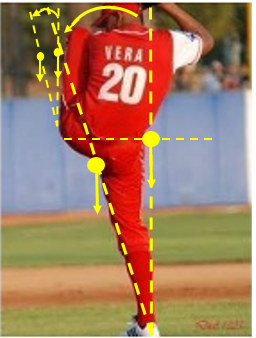 Source: https://www.ecured.cu/Lanzador_ (Beisbol)#/media/File:Norge_luis_vera.jpg
Source: https://www.ecured.cu/Lanzador_ (Beisbol)#/media/File:Norge_luis_vera.jpg
Fig. 3. - The pitcher as an inverted pendulum as a function of the fast pitch
Very few pitchers of those observed take advantage of this intentional imbalance or imbalance, almost imperceptible within the kinetic chain, because it occurs very quickly, but, if he decides to take advantage of it, he must know what it would contribute to the velocity of the pitch: Understand that the rotational balance of a body is classified into three categories: stable, unstable and indifferent (Tipler & Mosca, 2010, p. 349). And during the entire technical gesture of the pitcher, two are appreciated: stable equilibrium during and in the final position of phase I and an unstable equilibrium at the beginning of phase II, like an inverted pendulum, which generates in the system, that the weight (yellow vertical arrow), in the line of gravity (yellow dashed vertical line), leaves the monopodal support base and its CG goes down (yellow circle), originating a projection of its weight in the direction and direction of movement of the system, (Figure 3), which contributes to the acceleration of the throwing arm an additional mechanical impulse that increases with the angle è of inclination and again to a stable equilibrium, subsequent to a firm stride, throwing the ball at the same time.
With the forward projection of the body, the drive leg is brought out with the non-dominant hip rotation (ROM), which generates the force of the drive of the attack leg to ensure a huge stride (Robb, Fleisig, Wilk, & et al., 2010), causing the rapid descent of the system from the top of the mound (about 25.4 cm), discharging all the gravitational potential energy stored with the bunching and in unison incorporating to the acceleration of the throwing arm, the rest of the mechanical energies accumulated in phase (I), plus the additional impulse by the weight component in the projection to home. Hence the advantage over the batter to be taken advantage of, when a wide stride from the mound is guaranteed.
Everything described is possible with the rotation and projection of the hip, simultaneously with the acceleration of the throwing arm, which is materialized by supporting the drive leg and throwing the ball (end of phase II). This author considers that an excessive range of rotation of the pelvis and feet originates a loss of all the total mechanical energy stored and, therefore, the decrease of the angular velocity of the system, when the system releases the elastic potential energy, which must be avoided at all costs (Figure 4).
Something similar raises Ellenbecker (Ellenbeck, Robert, Davies, & et al., 2002), by highlighting that by increasing or decreasing the internal rotation and active external rotation of the hip, decreases the abduction force of the driving leg and limits the transfer of total mechanical energy stored and imposes an unnecessary load on the shoulder and, as a consequence, presents injuries in the upper extremities, mainly motivated by the increase of valgus in the throwing elbow (Manabu Saito & et al., 2014).
Physical explanation of phase III: final phase
This phase is the evidence of the quality and effectiveness of the technical gesture and compliance with the entire kinetic sequence of movements, is where the pitcher shows external control during the kinetic and angular deceleration of the entire system and the inertia of the body, since some parts of the system tend to continue its state of accelerated rotational movement (Figure 5). And, not knowing how to counteract such effect, can destabilize it and even make it fall, such as producing hip, back and knee injuries, among other possible ones.
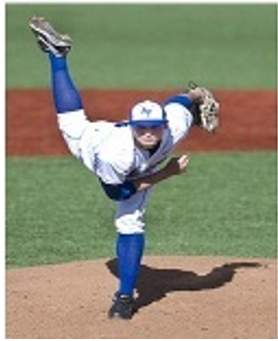 Source: https://pixabay.com/es/photos/b%C3%A9isbol-deportes-lanzador-ont%C3%ADculo-89612/
Source: https://pixabay.com/es/photos/b%C3%A9isbol-deportes-lanzador-ont%C3%ADculo-89612/
Fig. 5. - Support foot and hip inertia
There is no doubt that "there is a lot of physics in baseball (Flores Valdés, 2016) and it has been shown that science Physics explains and supports in baseball the reason for the mechanical-energetic logic of the kinetic sequence of the three phases of the pitcher's technical gesture and why it has to be uninterrupted and without pauses, and only if he is aware of what the biomechanics of his body contributes, each phase and why he should do it that way. Then he will be a spectacular pitcher, with good results and that minimizes injuries.
REFERENCIAS BIBLIOGRÁFICAS
Becerra, A., & Sanchez, A. (2016). Análisis de los movimientos corporales durante el lanzamiento de un pitcher. Universidad de los Andes. https://doi.org/10.13140/RG.2.2.33649.07527 [ Links ]
Ellenbecker, T. S., Roetert, E. P., Bailie, D. S., Davies, G. J., & Brown, S. W. (2002). Glenohumeral joint total rotation range of motion in elite tennis players and baseball pitchers. Medicine and Science in Sports and Exercise, 34(12), 2052-2056. https://doi.org/10.1097/00005768-200212000-00028 [ Links ]
García-López, J., & Rodríguez-Marroyo, J. (2015). Equilibrio y estabilidad del cuerpo humano (pp. 99-129). Publisher: Paidotribo. https://www.researchgate.net/publication/309579800_Equilibrio_y_estabilidad_del_cuerpo_humano [ Links ]
Pilotos Martinez, A. (2012). Análisis biocinemático de la ejecución técnica del lanzamiento rápido en los lanzadores de béisbol de la categoría 15-16 años de la EIDE `Ormani Arenado' de Pinar del Río. EFDeportes.com, Revista Digital. Buenos Aires, 16(165). https://www.efdeportes.com/efd165/analisis-biocinematico-del-lanzamiento-en-beisbol.htm [ Links ]
Robb, A. J., Fleisig, G., Wilk, K., Macrina, L., Bolt, B., & Pajaczkowski, J. (2010). Passive ranges of motion of the hips and their relationship with pitching biomechanics and ball velocity in professional baseball pitchers. The American Journal of Sports Medicine, 38(12), 2487-2493. https://doi.org/10.1177/0363546510375535 [ Links ]
Saito, M., Kenmoku, T., Kameyama, K., Murata, R., Yusa, T., Ochiai, N., Kijima, T., Takahira, N., Fukushima, K., Ishige, N., & Takaso, M. (2014). Relationship Between Tightness of the Hip Joint and Elbow Pain in Adolescent Baseball Players. Orthopaedic Journal of Sports Medicine, 2(5) ISSN: 2325-9671. https://doi.org/10.1177/2325967114532424 [ Links ]
Sáiz Domínguez, C. (2016). La Física importa y mucho en el mundo del béisbol. El Universo, CIENCIA EN EL DEPORTE. https://as.com/masdeporte/2016/02/09/mlb/1455037583_614003.html [ Links ]
Tipler, P. A., & Mosca, G. (2010). Física para la ciencia y la tecnología. 1A: Mecánica. Editorial Reverte. https://books.google.com.cu/books/about/F%C3%ADsica_para_la_ciencia_y_la_tecnolog%C3%ADa.html?id=TJhLmwEACAAJ&redir_esc=y [ Links ]
Young, H. D., Freedman, R. A., & Sears, F. W. (2013). Física universitaria 01. Addison-Wesley/Pearson Educación. https://books.google.com.cu/books/about/F%C3%ADsica_universitaria_01.html?id=qtsXYAAACAAJ&redir_esc=y [ Links ]
Received: November 11, 2019; Accepted: April 23, 2020











 texto en
texto en 

